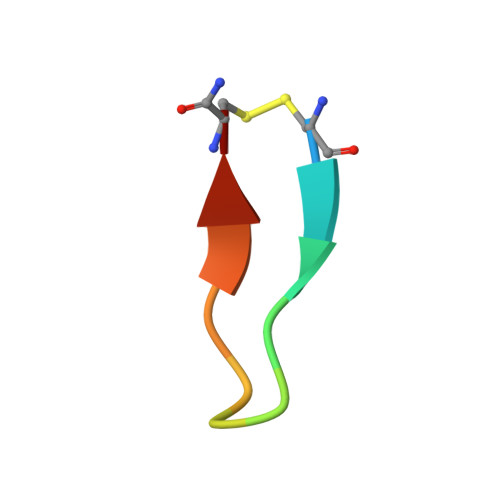Turn stability in beta-hairpin peptides: Investigation of peptides containing 3:5 type I G1 bulge turns
Blandl, T., Cochran, A.G., Skelton, N.J.(2003) Protein Sci 12: 237-247
- PubMed: 12538887
- DOI: https://doi.org/10.1110/ps.0228603
- Primary Citation of Related Structures:
1N0A - PubMed Abstract:
The turn-forming ability of a series of three-residue sequences was investigated by substituting them into a well-characterized beta-hairpin peptide. The starting scaffold, bhpW, is a disulfide-cyclized 10-residue peptide that folds into a stable beta-hairpin with two antiparallel strands connected by a two-residue reverse turn. Substitution of the central two residues with the three-residue test sequences leads to less stable hairpins, as judged by thiol-disulfide equilibrium measurements. However, analysis of NMR parameters indicated that each molecule retains a significant folded population, and that the type of turn adopted by the three-residue sequence is the same in all cases. The solution structure of a selected peptide with a PDG turn contained an antiparallel beta-hairpin with a 3:5 type I + G1 bulge turn. Analysis of the energetic contributions of individual turn residues in the series of peptides indicates that substitution effects have significant context dependence, limiting the predictive power of individual amino acid propensities for turn formation. The most stable and least stable sequences were also substituted into a more stable disulfide-cyclized scaffold and a linear beta-hairpin scaffold. The relative stabilities remained the same, suggesting that experimental measurements in the bhpW context are a useful way to evaluate turn stability for use in protein design projects. Moreover, these scaffolds are capable of displaying a diverse set of turns, which can be exploited for the mimicry of protein loops or for generating libraries of reverse turns.
Organizational Affiliation:
Department of Protein Engineering, Genentech, South San Francisco, California 94080, USA.














